China Passenger Car Electronically Controlled Suspension Industry Report, 2022
Research on electronically controlled suspension: four development trends of electronically controlled suspension and air suspension
Basic concepts of suspension and electronically controlled suspension
Suspension is the generic term for all force-transmitting connection devices between the frame (or load-bearing body) and the axles (or wheels) of a vehicle. It transmits the force and torsion acting between the wheels and the frame, buffers the impact force on the frame or the body by uneven roads, and reduces the vibration caused thereby in a bid to ensure that the vehicle can run smoothly.
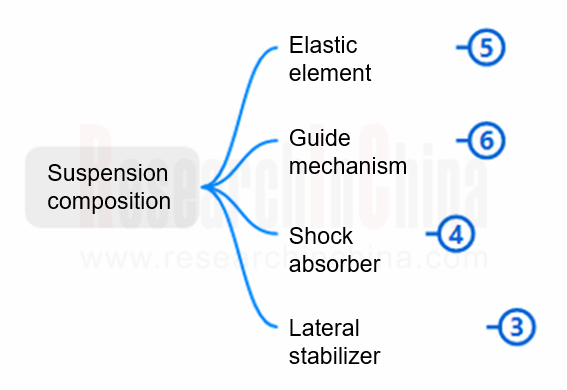
A typical suspension structure is composed of elastic elements, guide mechanisms and shock absorbers, and sometimes includes buffer modules and lateral stabilizer bars among others. Elastic elements are in the form of leaf springs, air springs, coil springs and torsion bar springs, of which coil springs and torsion bar springs are mostly used by modern cars and air springs are adopted by some high-end cars. Elastic elements are often used to withstand vertical force and convert it into elastic potential energy, thereby mitigating the impact caused by the vehicle running on the bumpy road.
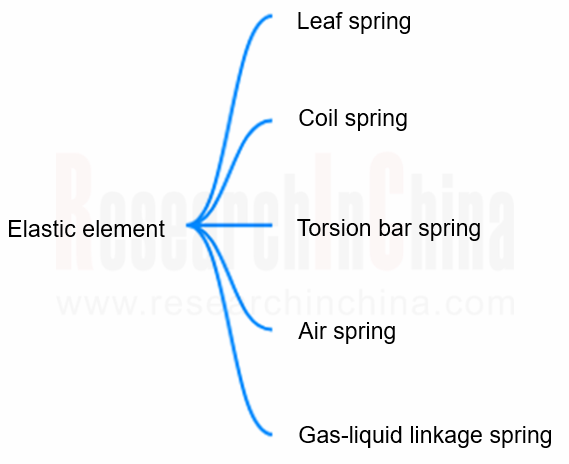
Shock absorbers absorb and release the elastic potential energy of elastic elements (usually discharged in the form of heat energy), and thus rapidly attenuate the vibration of the frame and the body, preventing the body from repeated bumps caused by the expansion and contraction of elastic elements. They change the cross section to alter the damping coefficient, and determine the softness and stiffness of the suspension according to the driving state. The Continuous Damping Control (CDC) offered by ZF is a mainstream electronically controlled shock absorber. It checks the road conditions 100 times per second, and changes the size of the internal valve according to the data sent by sensors, thereby adjusting the flow and then changing the damping that affects the softness and stiffness of the suspension, so as to achieve: 1) anti-roll when turning; 2) fewer nose dives when braking; 3) more ride comfort.
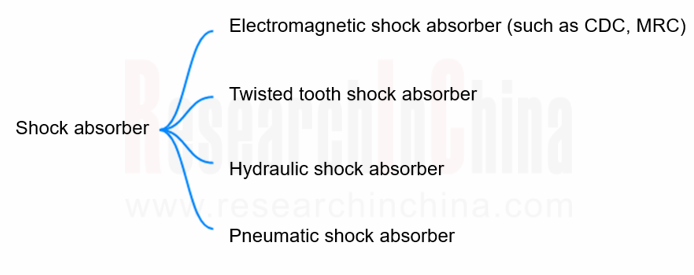
As the levels of electronic control get higher, electronically controlled suspension came into being. Electronically controlled suspension refers to a system that controls the suspension actuator through the electronic control system, adjusts damping, height and stiffness, and applies active force to improve vehicle comfort and stability.
A suspension electronic control unit (ECU) collects height, speed, steering wheel angle, brake wheel cylinder pressure, driving mode, etc. as input signals through sensors and CAN bus. Algorithms are then used to process these signals and make out the control signal that enables the optimal system control performance. The drive circuit controls the time when the solenoid valve is energized or de-energized, or its current, adjusts the inflation and deflation of air springs, or regulates the damping force of shock absorbers, thus realizing adjustment of the stiffness and damping of the suspension.
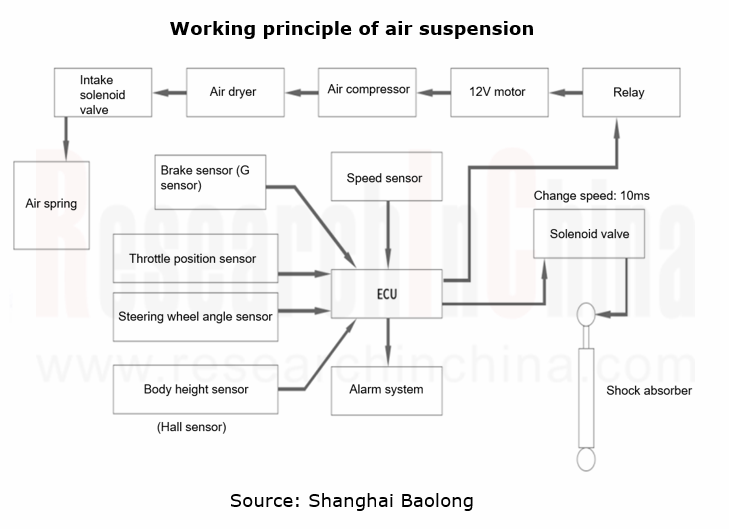
At present, the suspension industry focuses on promoting air suspension systems. In general, vehicle models equipped with air springs also come complete with MRC or CDC; however, those with MRC or CDC are not necessarily fitted with air springs.
Development trend 1: the penetration rate of air suspension is as low as 0.7% in Chinese passenger car market.
In terms of commercial vehicles, air suspension finds wider application in commercial vehicles as regulations require mandatory installation. According to the Technical Specifications for Safety of Power-Driven Vehicles Operating on Roads (2017), the rear axles of trucks (cross weight: ≥12,000kg) transporting hazardous articles, all semi-trailers transporting hazardous articles, and three-axle balustrade and silo-type semi-trailers should be equipped with air suspension since January 1, 2020. The penetration rate of air suspension in Chinese commercial vehicles remains very low, compared with about 85% in rich world, leaving plenty of space to grow.
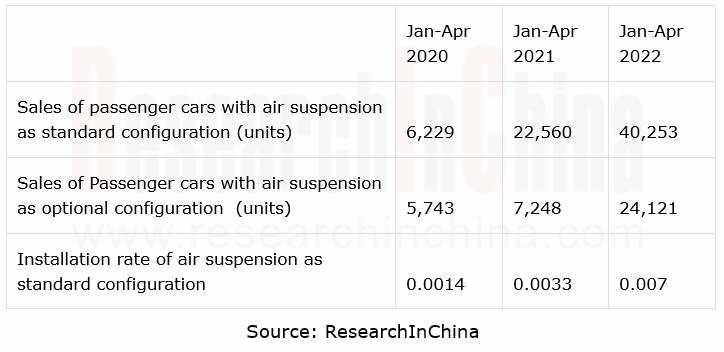
According to the statistics of ResearchInChina, the air suspension penetration in the imported passenger car market was about 25% from January to April 2022, compared with about 0.7% in the China-made passenger car market.
Development trend 2: Chinese OEMs and Tier 1 suppliers are rapidly lowering the application threshold of air suspension.
Air suspension makes cars much easier to maneuver and far more comfortable. It is mostly used in imported luxury cars priced at more than RMB600,000, such as Mercedes-Benz, BMW, Audi, Volvo, Land Rover and Porsche. Emerging carmakers like NIO, Xpeng and Li Auto, and conventional automakers including Geely, FAW-Hongqi and Great Wall Motor install air suspension on their high-end smart cars for branding. They either work on independent full-stack development, or cooperate with air suspension suppliers, realizing downward penetration of air suspension.
Chinese automakers may tend to develop their own air suspension control units and algorithms (which are eventually integrated into chassis domain controllers). They split hardware assembly into air supply units, air springs, sensors and other components, and purchase them separately. Then OEMs take on the ultimate integration. This mode brings opportunities to domestic component suppliers to make breakthroughs at a single point, for example, Shanghai Baolong, Zhongding Sealing Parts, Tuopu Group, and KH Automotive Technologies among others have gradually achieved mass production and supply of air suspension components.
At present, the air suspension of a single vehicle is worth about RMB11,000-16,000. With the localization of the supply chain and the increase in production, the average price of passenger car air suspension made in China is expected to drop to less than RMB8,000.
Driven by consumption upgrade and localization, air suspension is sinking to RMB600,000 to RMB300,000 models of emerging automakers as an optional or even a standard configuration from luxury cars priced at RMB600,000. Since 2018, the launch of NIO ES8 and ES6 has downgraded air suspension to vehicles with prices lower than RMB400,000. In 2021, ZEEKR 001 and Dongfeng Voyah FREE further pushed air suspension down to models within RMB300,000.
In the clear trend of automobile consumption upgrade in China, models valued above RMB200,000 has made up much more of the total sales, with the proportion up from 17.3% in 2016 to 30% in 2021. The upgrade of automobile consumption has also accelerated the penetration of air suspension.
KH Automotive Technologies has its own air spring assembly line, with the planned annual capacity of the Phase I up to 150,000 sets. Tuopu Group's first air suspension system factory is located in Ningbo Binhai New Area, with the total investment of about RMB600 million. The facility is scheduled to come into operation in June 2022, producing 2 million sets of air suspension annually for 500,000 vehicles.
Shanghai Baolong has invested RMB1 billion in building an air spring production line in Hefei, with the annual capacity supporting 100,000 vehicles. The second and third lines will start production in 2023. Another six production lines are planned to be built in the future. In 2025, the company will boast air spring capacity that supports more than 500,000 vehicles.
The operation of a large number of air spring production lines in China will surely facilitate the mass adoption of air springs in vehicles, laying a hardware foundation for the introduction of higher-level suspension functions such as Magic Carpet Suspension.
Development trend 3: Magic Carpet suspension springs up.
Common air suspension systems often allow manual selection of driving modes which differ in suspension settings. Magic Carpet suspension goes a step further, scanning the pavement in front of the car through cameras and radars to adjust the damping, height and stiffness of the air suspension so as to smoothly pass through bumpy roads. Magic Carpet suspension generally has one more environmental perception system (vision and radar, etc.) and controllers with higher computing power (the computing power of domain controllers may be used) than air suspension.
The environmental perception system most widely used in Magic Carpet suspension is the stereo vision system. Mercedes-Benz's Magic Carpet suspension system is called the MAGIC BODY CONTROL which uses a stereo vision system. BMW also uses stereo cameras as a perception system.
The BMW Magic Carpet Suspension is composed of the following systems: dynamic damping control system, integral active steering system, intelligent all-wheel drive system, 4 wheel speed sensors, electric active stabilizer bars on the front and rear axles, 12V battery and inverter, and front windshield stereo camera.
Among Chinese stereo vision suppliers, Smarter Eye and Shanghai Baolong have both secured designated projects for Magic Carpet suspension.
Voyah first introduced the "Magic Carpet" function to its MPV Dreamer. The solution is comprised of the following units: four CDC shock absorbers, five acceleration sensors, cameras & control units, and front double wishbone + rear five-link + air suspension. The front camera scans the pavement 5 to 15 meters in front of the vehicle in real time to detect special road conditions such as speed bumps and road bulges. Meanwhile, sensors monitor the movement of the vehicle and transmit the movement signal to the control unit which then calculates the sensor signal and output the control current to the solenoid valves on four CDC shock absorbers according to the internal control algorithms, thus controlling the damping force to offer more driving comfort.
Development trend 4: suspension control needs to combine with steering, braking control, and ADAS functions
In the chassis control of luxury brands, electronically controlled suspension never exists independently, and instead often combines with steering and brake control systems, such as Mercedes-Benz's E-Active Body Control System.
Mercedes-Benz's E-Active Body Control uses five multi-core processors, more than 20 sensors, and stereo cameras to predict different driving situations. The specific functions are described as follows:
* Based on 48V fully active suspension, handling characteristics vary more than ever in driving modes;
* E-ACTIVE BODY CONTROL controls the damping and springs force of each shock absorber separately, which can suppress the body rolling, pitching and lifting movements;v
* In the COMFORT driving mode, ROAD SURFACE SCAN uses the SMPC stereo multi-function camera to monitor the pavement ahead of the vehicle. The spring struts are then activated to reduce much of body shake and vibration when going through bumps;
* In the CURVE driving mode, the vehicle will actively tilt according to the condition. The tilt function and comfortable suspension settings deliver far more ride comfort, especially for passengers with more sensitive stomachs (when they are stuffed);
* E-ACTIVE BODY CONTROL in concert with PRE-SAFE is able to reduce the damage from a side impact.
* Thanks to rear-axle steering (optional), the S-Class feels as manoeuvrable as a compact car in the city. The steering angle at the rear axle is up to ten degrees. The turning circle is reduced by up to two meters. This enables the turning diameter of the long-wheelbase S-Class to be less than 11 meters;
* The combination of rear-wheel steering with more direct front-wheel steering enables high levels of agility and high-speed stability;
* The integration of steering and braking systems offers more precise and stable operation in dynamic situations.
Like ADAS, Magic Carpet suspension also requires an environmental perception system, so the two can share some sensors. Among Chinese enterprises, Smarter Eye and Shanghai Baolong have launched “Magic Carpet suspension + ADAS” fusion perception solutions together with their partners.
New Energy Vehicle Cross-Domain (Electric Drive System and Powertrain Domain) Integration Trend Report 2025-2026
Electric Drive and Powertrain Domain Research: New technologies such as three-motor four-wheel drive, drive-brake integration, and corner modules are being rapidly installed in vehicles.
Electric dri...
Analysis on Desay SV and Joyson Electronic's Electrification, Connectivity, Intelligence and Sharing, 2025
Research on Desay SV and Joyson Electronic: Who is the No.1 Intelligent Supplier?
Both Desay SV and Joyson Electronic are leading domestic suppliers in automotive intelligence. "Analysis on Desay SV ...
OEMs and Tier 1 Suppliers' Cost Reduction and Efficiency Enhancement Strategy Analysis Report, 2025
ResearchInChina released the "OEMs and Tier 1 Suppliers' Cost Reduction and Efficiency Enhancement Strategy Analysis Report, 2025", summarizing hundreds of cost reduction strategies to provide referen...
Automotive Fixed Panoramic Sunroof and Smart Roof Research Report, 2025
With the intelligent application of car roofs as the core, this report systematically sorts out a series of new products such as fixed panoramic sunroof/openable sunroof, ceiling screen, roof ambient ...
Automotive-Grade Power Semiconductor and Module (SiC, GaN) Industry Research Report, 2025
SiC/GaN Research: Sales volume of 800V+ architecture-based vehicles will increase more than 10 times, and hybrid carbon (SiC+IGBT) power modules are rapidly being deployed in vehicles.
Sales volume o...
Cockpit Agent Engineering Research Report, 2025
Cockpit Agent Engineering Research: Breakthrough from Digital AI to Physical AI
Cockpit Agent Engineering Research Report, 2025 starts with the status quo of cockpit agents, summarizes the technical ...
Prospective Study on L3 Intelligent Driving Technology of OEMs and Tier 1 Suppliers, 2025
L3 Research: The Window of Opportunity Has Arrived - Eight Trends in L3 Layout of OEMs and Tier 1 Suppliers
Through in-depth research on 15 OEMs (including 8 Chinese and 7 foreign OEMs) and 9 Tier 1 ...
China Commercial Vehicle IoV and Intelligent Cockpit Industry Research Report 2025
Commercial Vehicle IoV and Cockpit Research: The Third Wave of Passenger Car/Commercial Vehicle Technology Integration Arrives, and T-Box Integrates e-Call and 15.6-inch for Vehicles
I. The third wav...
Intelligent Vehicle Electronic and Electrical Architecture (EEA) and Technology Supply Chain Construction Strategy Research Report, 2025
E/E Architecture Research: 24 OEMs Deploy Innovative Products from Platform Architectures to Technical Selling Points
According to statistics from ResearchInChina, 802,000 passenger cars with domain...
Research Report on Intelligent Vehicle Cross-Domain Integration Strategies and Innovative Function Scenarios, 2025
Cross-Domain Integration Strategy Research: Automakers' Competition Extends to Cross-Domain Innovative Function Scenarios such as Cockpit-Driving, Powertrain, and Chassis
Cross-domain integration of ...
China Autonomous Driving Data Closed Loop Research Report, 2025
Data Closed-Loop Research: Synthetic Data Accounts for Over 50%, Full-process Automated Toolchain Gradually Implemented
Key Points:From 2023 to 2025, the proportion of synthetic data increased from 2...
Automotive Glass and Smart Glass Research Report, 2025
Automotive Glass Report: Dimmable Glass Offers Active Mode, Penetration Rate Expected to Reach 10% by 2030
ResearchInChina releases the Automotive Glass and Smart Glass Research Report, 2025. This r...
Passenger Car Brake-by-Wire (BBW) Research Report, 2025
Brake-by-Wire: EHB to Be Installed in 12 Million Vehicles in 2025
1. EHB Have Been Installed in over 10 Million Vehicles, A Figure to Hit 12 Million in 2025.
In 2024, the brake-by-wire, Electro-Hydr...
Autonomous Driving Domain Controller and Central Computing Unit (CCU) Industry Report, 2025
Research on Autonomous Driving Domain Controllers: Monthly Penetration Rate Exceeded 30% for the First Time, and 700T+ Ultrahigh-compute Domain Controller Products Are Rapidly Installed in Vehicles
L...
China Automotive Lighting and Ambient Lighting System Research Report, 2025
Automotive Lighting System Research: In 2025H1, Autonomous Driving System (ADS) Marker Lamps Saw an 11-Fold Year-on-Year Growth and the Installation Rate of Automotive LED Lighting Approached 90...
Ecological Domain and Automotive Hardware Expansion Research Report, 2025
ResearchInChina has released the Ecological Domain and Automotive Hardware Expansion Research Report, 2025, which delves into the application of various automotive extended hardware, supplier ecologic...
Automotive Seating Innovation Technology Trend Research Report, 2025
Automotive Seating Research: With Popularization of Comfort Functions, How to Properly "Stack Functions" for Seating?
This report studies the status quo of seating technologies and functions in aspe...
Research Report on Chinese Suppliers’ Overseas Layout of Intelligent Driving, 2025
Research on Overseas Layout of Intelligent Driving: There Are Multiple Challenges in Overseas Layout, and Light-Asset Cooperation with Foreign Suppliers Emerges as the Optimal Solution at Present
20...